Samsung Galaxy S III Review - AT&T and T-Mobile USA Variants
by Brian Klug on June 20, 2012 12:01 AM ESTI was sampled both the AT&T and T-Mobile SGS3s, so I can really only speak to those particular variants. However, all five of the USA SGS3s use MSM8960’s onboard cellular baseband for their respective cellular interfaces. I’m including the table from our original MSM8960 piece almost a year ago, since that shows the capabilities of the baseband - of course, whether or not your device supports all these things is a function of the rest of the RF chain, including transceiver and power amplifiers.
| Snapdragon S4 - MSM8960 Cellular Support | |||||
| LTE FDD | 100 Mbps DL / 50 Mbps UL (Cat. 3, 3GPP Rel.9) | ||||
| LTE TDD | 68 Mbps DL / 17 Mbps UL (Cat. 3, 3GPP Rel.9) | ||||
| UMTS | DC-HSPA+ 42 Mbps DL (Cat. 24) / 11 Mbps UL (Cat. 8) | ||||
| CDMA2000 | 1xAdvanced, EVDO Rev.B (14.7 Mbps DL / 5.4 Mbps UL) | ||||
| GSM | GSM/GPRS/EDGE | ||||
| TD-SCDMA | TD-SCDMA 4.2 Mbps DL / 2.2 Mbps UL | ||||
In the case of the AT&T SGS3, that’s LTE on bands 17 and 4 as shown in the table below. What’s unique about the AT&T LTE SGS3 is that it’s the first device in the USA I’ve seen with support for both 15 and 20 MHz FDD-LTE on Band 4 (AWS). That should tell you something about the product development cycle here, specifically that the AT&T SGS3 was conceived of back when AT&T was confident about getting T-Mobile’s AWS holdings. In addition, all of the cellular connectivity on the AT&T SGS3 sits on the same transmit path, with transmit at the bottom and receive diversity up at the top.
| SGS3 AT&T - Network Support | |||||
| GSM/EDGE Support | 850 / 900 / 1800 / 1900 MHz | ||||
| WCDMA Support | 850 / 1900 / 2100 MHz | ||||
| LTE Support | 700 / 1700 MHz (LTE Band 17, 4), Category 3 | ||||
| Baseband Hardware | Qualcomm MSM8960 | ||||
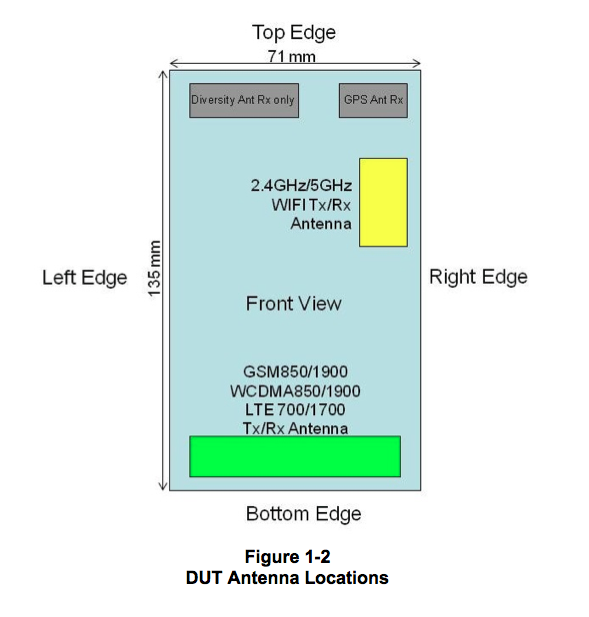
The T-Mobile SGS3 is unsurprisingly very similar to the AT&T SGS3, including support for both their own bands and AT&T’s bands for WCDMA as shown in the table below. The T-Mobile device of course supports WCDMA carrier aggregation, or DC-HSPA+. For those that aren’t familiar, DC-HSPA+ Category 24 (3GPP Rel.8) employes carrier aggregation in addition to the other HSPA+ features from Release 7. Essentially, two 5 MHz WCDMA carriers are aggregated together on the downlink, resulting in roughly double the performance of a single WCDMA carrier situation. Note that the uplink remains single carrier, so there’s even more of an asymmetry that happens, but given the traffic asymmetry that already exists for most mobile workloads this isn’t a huge deal.
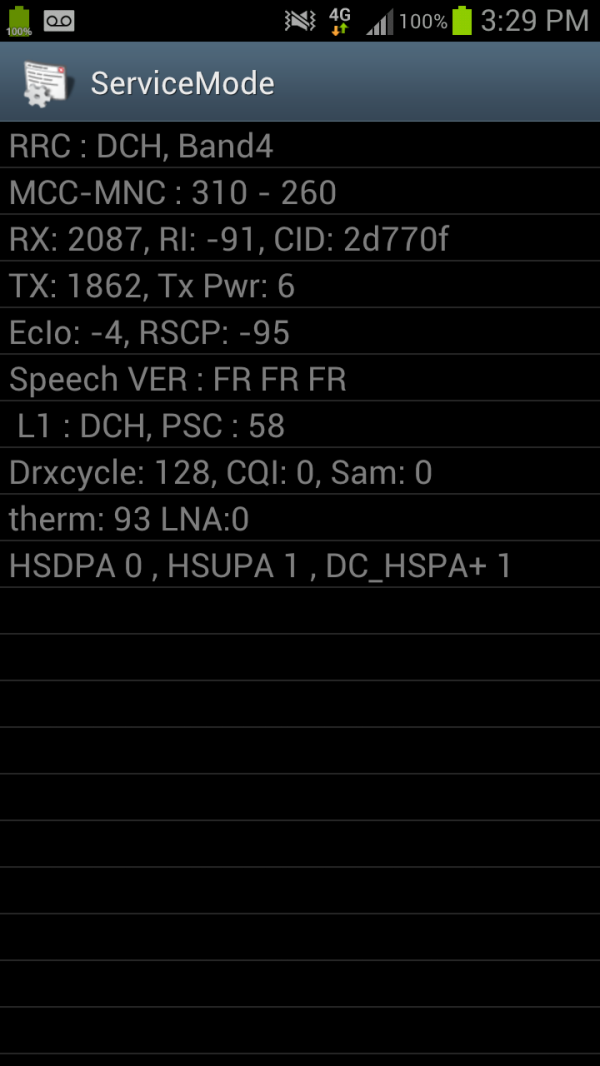
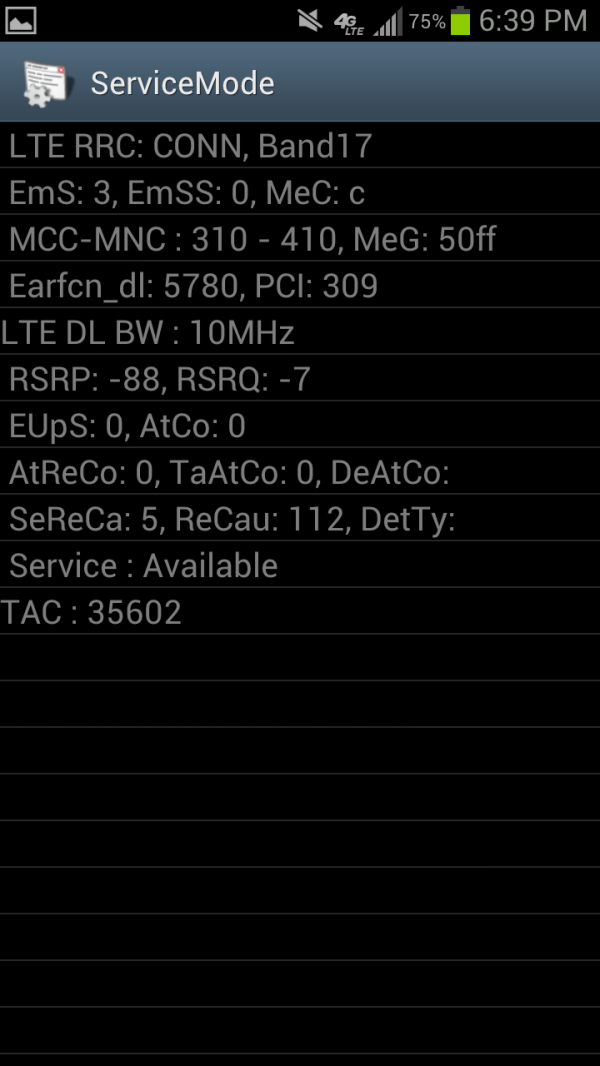
Samsung's excellent ServiceMode (*#0011#) is present on all the USA SGS3 variants, DC-HSPA+ shown on T-Mobile SGS 3 (left), 10 MHz FDD-LTE shown on AT&T Model (right)
Like the HTC One S, the T-Mobile SGS3 can be used on AT&T’s 3G network if you can manage to unlock one. This is a definite plus if you don’t care about LTE but do care about having a phone with a ton of WCDMA bands supported.
| SGS3 T-Mobile - Network Support | |||||
| GSM/EDGE Support | 850 / 900 / 1800 / 1900 MHz | ||||
| WCDMA Support | 850 / 1700 / 1900 / 2100 MHz | ||||
| HSPA Speeds | HSDPA 42.2 (Cat.24) / HSUPA 5.76 (Cat.6) | ||||
| Baseband Hardware | Qualcomm MSM8960 | ||||
Because of my limited time with the SGS3s, I haven’t had a chance to run a bunch of speedtests on AT&T LTE and report back with plots. In addition, because AT&T does not support DC-HSPA+ yet (and shows no indication of doing so), there’s not much to be learned from 3G WCDMA there, as it’s still just HSDPA 14.4 in my market and almost all others. I’ve still never seen a single AT&T market with 64QAM / HSDPA 21.1. I will update with AT&T LTE results when I have them.
I have however run a bunch on the T-Mobile in my home market of Tucson, AZ and compiled enough to generate some plots. To test, I used the same workflow as always, essentially running as many tests as possible using Ookla’s speedtest.net application on Android, exporting the results, and making some pretty graphs with python. I’ve rewritten my graphing code and prettied it up a bit as well with some stats.
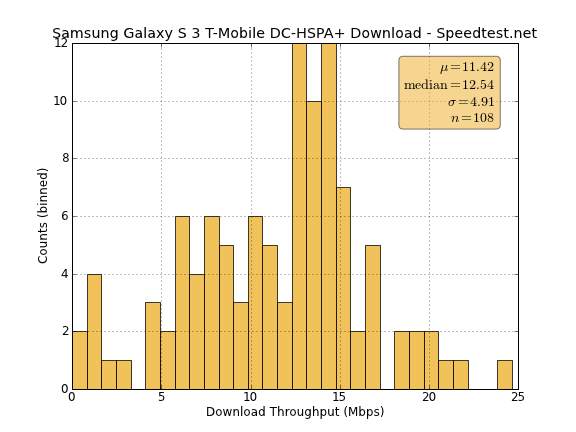
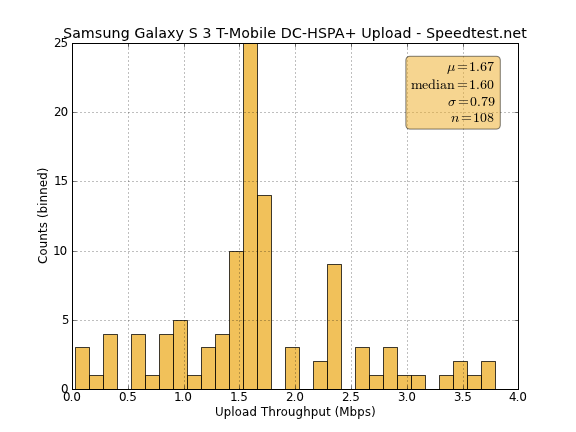
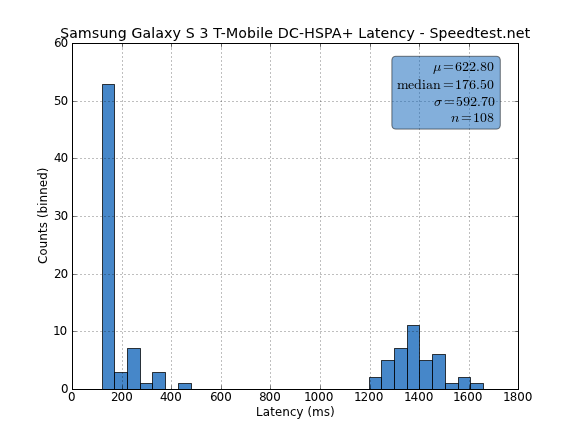
Unsurprisingly DC-HSPA+ is impressively fast on the downlink, with an average of around 11 Mbps and a maximum of just above 20 Mbps. It’s not the kind of performance you’ll get out of LTE (proving somewhat that using subcarriers through OFDMA and other enhancements does pay off), but it’s pretty darn impressive nonetheless. There’s a weird double distribution in latency probably due to setup time coming out of CELL_PCH and setting up the DC-HSPA+ link. Running a test right after this setup yields much lower latency thanks to T-Mobile’s flat IP network, which is why I say it seems to be connection setup related. I’m impressed with how fast T-Mobile’s DC-HSPA+ is in my area, and DC-HSPA+ isn’t a bad interim air interface until the carrier can deploy LTE. You have to applaud T-Mobile for being first to both deploy 64QAM on the downlink (HSDPA 21.1) and deploy DC-HSPA+, two things AT&T still has no intention of doing anytime soon.
I’m headed to an AT&T LTE enabled market as soon as possible to get some AT&T LTE results, but I don’t expect any surprises from that particular device.
WiFi
On the USA SGS3s, I was surprised to find that Samsung hasn’t gone with the on-SoC WLAN and instead implemented BCM4334, mirroring what was done in the international SGS3. BCM4334 we have talked about a lot before, it’s the 45nm version of BCM4330 with added support for 40 MHz channels on 5 GHz, among other lower power features and improvements. Of course, the SGS3s also include NFC (from the incredibly ubiquitous PN544) and BT 4.0 support (from BCM4334).
One of our readers pinged me and let me know that reliable iperf ports are now available on Android and iOS, so I’ll be switching over to using iperf for my main WiFi throughput testing instead of the 100 MB PDF hosted locally. What I’m looking at is still downstream throughput to the phone, since I wager that’s the direction people care most about. I tested a small number of the phones I’ve got on hand with iperf on the new Buffalo 802.11ac compatible router for comparison. For the purposes of the test I’ll be choosing the fastest WiFi interface possible for the device, eg 5 GHz when supported, 2.4 GHz when not supported.
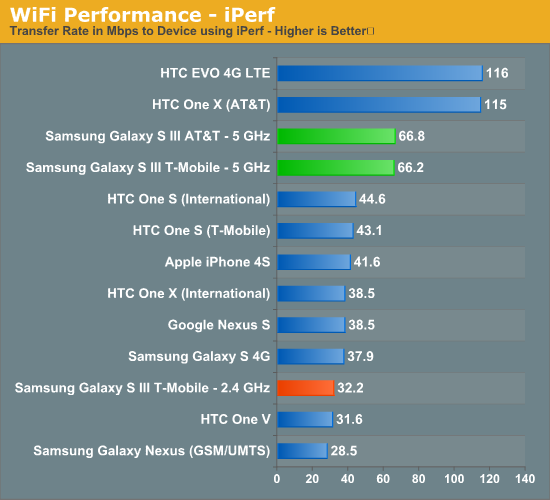
The SGS3s show a PHY of 150 Mbps on 5 GHz with 40 MHz channels, and 65 Mbps on 2.4 GHz with 20 MHz channels. Performance isn’t quite up to the MSM8960 devices like the EVO 4G LTE and One X. I suspect this is due to either limitations on the interface between the SoC and BCM4334, or possibly absence of some other MAC features. Either way I’m glad to see 5 GHz support advancing even more now, to the point where devices are starting to show up with 40 MHz onboard as well.
GNSS
The SGS3 includes onboard GNSS (Global Navigation Satellite System) configuration. In this case, that means GPS with GLONASS. I have no problems getting a fast lock even indoors or in an urban environment, and like other combos with GLONASS you can see those satellites pop into use when GPS signal is weak.
I’m unclear whether the USA SGS3s have gone with Broadcom’s BCM47511 GNSS like what was done in the international SGS3, or whether Samsung is using the MSM8960 onboard GNSS. I need to do more digging to be certain. I suspect this is done on MSM8960, however.
Speakerphone and Sound
Because I’m in the process of moving, I don’t have my sound testing setup complete, nor the sound meter for testing speakerphone. However, I will be able to get that data in the coming week and update with my findings.
Both the AT&T and T-mobile SGS3s use an Audience A2220 for noise rejection using those two microphones (at top and bottom) as well. I need to do my testing here but based on a number of calls I’ve placed already from both I suspect they’ll perform quite well.


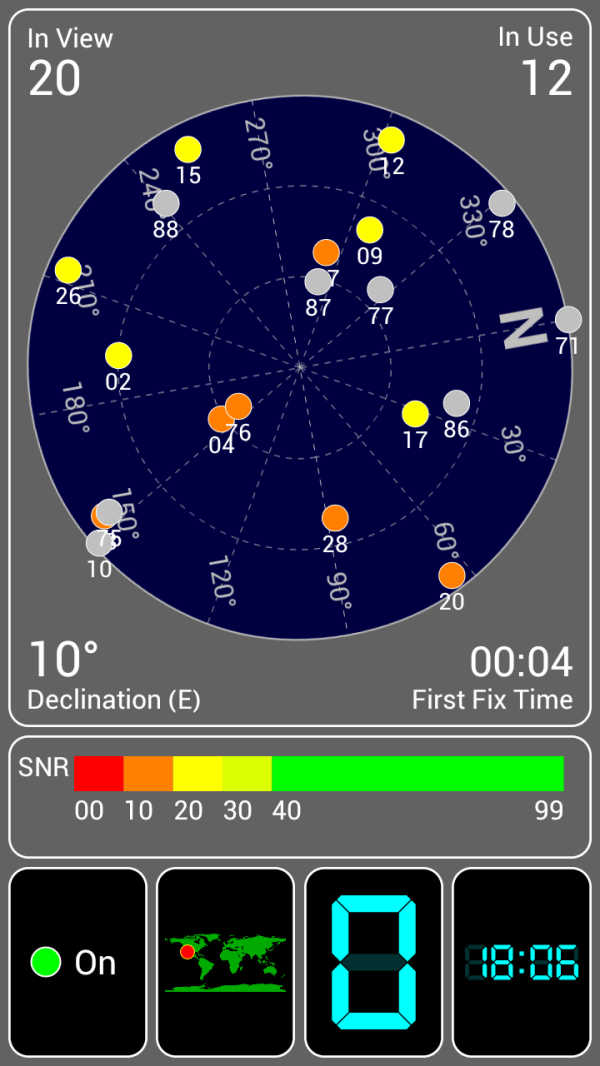
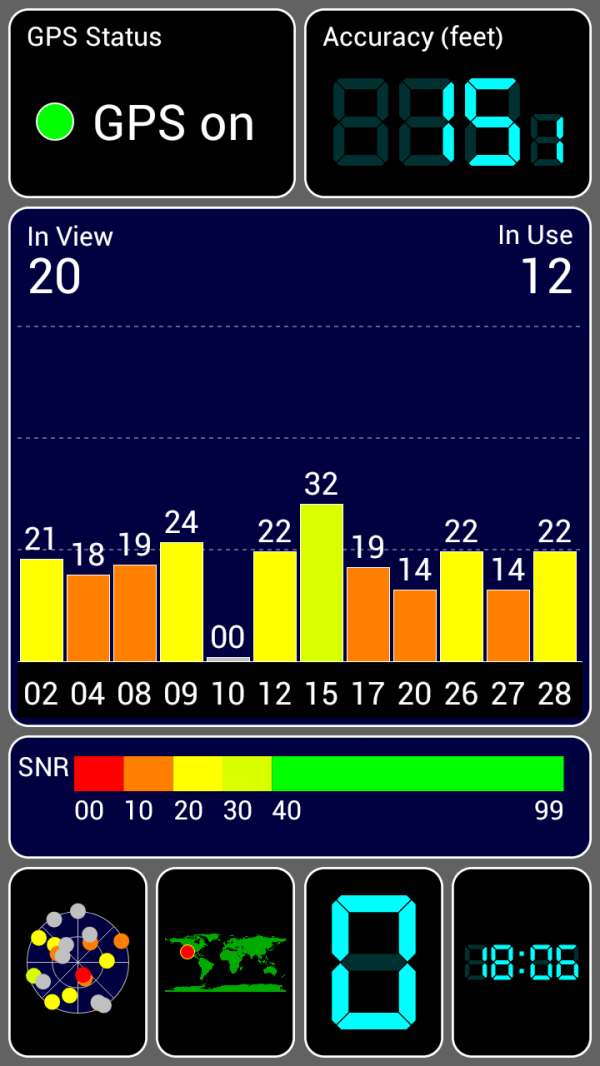








107 Comments
View All Comments
duffman55 - Sunday, July 8, 2012 - link
Does the AT&T model have the option to change color profiles so we can choose to have less oversaturated colors? For example, the international version has the option to switch between dynamic, standard, natural, and movie "screen modes". I thought I remembered reading that these would be available this time around unlike the AT&T version of the S2.stargate125645 - Saturday, July 14, 2012 - link
Why is there no mention of the anti-aliasing unfairly penalizing the Adreno 225? Was it turned off?For reference, see this article:
http://www.anandtech.com/show/5559/qualcomm-snapdr...
stargate125645 - Saturday, July 14, 2012 - link
I see that the AA issue was only for the Basemark ES, but I still don't understand how the Mali-400 (not the new MP4 version) is better than the Adreno 225.soofdawg - Sunday, July 15, 2012 - link
Wouldn't it be more appropriate to test battery life straight out of the box, without changing any settings, such as turning off battery saving features? Samsung obviously allows user control of such features, but Apple also uses measures for the iOS to maximize battery life without the option to turn off said software control. Even maximizing screen brightness does not equalize the testing, as you're dealing with varying screen sizes. I may be wrong, but I would think that simply testing any phone straight from the box is what majority of users will experience and provide more 'real world' results. Please correct me if I missed any details on your testing methods or completely off base.hurrakan - Tuesday, July 17, 2012 - link
Are you able to report anything about the sound in this phone yet?4 weeks ago you said:
"However, I will be able to get that data in the coming week and update with my findings."
Thanks!
packstrap - Thursday, August 16, 2012 - link
I like the Samsung Galaxy S III because of its elegant form factor. Especially when you look at it from all sides you see the perfection. In this video you can see it from all sides:http://www.youtube.com/watch?v=aaCg900NV2U
How about that? Thanks Samsung for making SGS III a super phone!
fixxxer0 - Wednesday, August 29, 2012 - link
The phone has been out a couple of months now... any news on the Verizon LTE version battery life numbers?